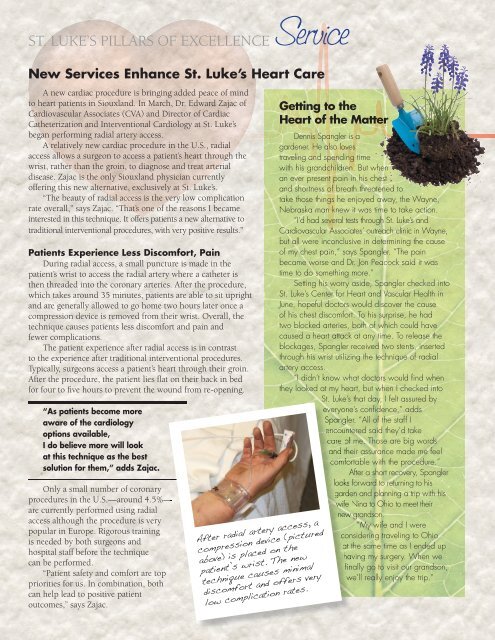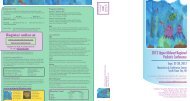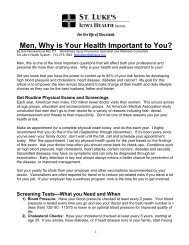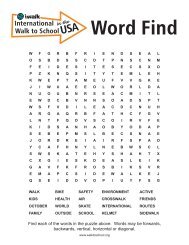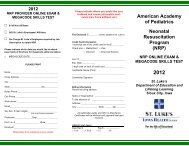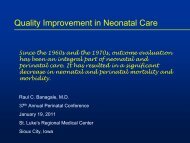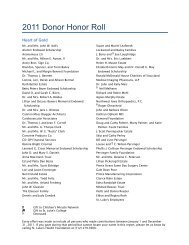Report to Our Community - St. Luke's Health System
Report to Our Community - St. Luke's Health System
Report to Our Community - St. Luke's Health System
Create successful ePaper yourself
Turn your PDF publications into a flip-book with our unique Google optimized e-Paper software.
ST. LUKE’S PILLARS OF EXCELLENCE<br />
New Services Enhance <strong>St</strong>. Luke’s Heart Care<br />
A new cardiac procedure is bringing added peace of mind<br />
<strong>to</strong> heart patients in Siouxland. In March, Dr. Edward Zajac of<br />
Cardiovascular Associates (CVA) and Direc<strong>to</strong>r of Cardiac<br />
Catheterization and Interventional Cardiology at <strong>St</strong>. Luke’s<br />
began performing radial artery access.<br />
A relatively new cardiac procedure in the U.S., radial<br />
access allows a surgeon <strong>to</strong> access a patient’s heart through the<br />
wrist, rather than the groin, <strong>to</strong> diagnose and treat arterial<br />
disease. Zajac is the only Siouxland physician currently<br />
offering this new alternative, exclusively at <strong>St</strong>. Luke’s.<br />
“The beauty of radial access is the very low complication<br />
rate overall,” says Zajac. “That’s one of the reasons I became<br />
interested in this technique. It offers patients a new alternative <strong>to</strong><br />
traditional interventional procedures, with very positive results.”<br />
Patients Experience Less Discomfort, Pain<br />
During radial access, a small puncture is made in the<br />
patient’s wrist <strong>to</strong> access the radial artery where a catheter is<br />
then threaded in<strong>to</strong> the coronary arteries. After the procedure,<br />
which takes around 35 minutes, patients are able <strong>to</strong> sit upright<br />
and are generally allowed <strong>to</strong> go home two hours later once a<br />
compression device is removed from their wrist. Overall, the<br />
technique causes patients less discomfort and pain and<br />
fewer complications.<br />
The patient experience after radial access is in contrast<br />
<strong>to</strong> the experience after traditional interventional procedures.<br />
Typically, surgeons access a patient’s heart through their groin.<br />
After the procedure, the patient lies flat on their back in bed<br />
for four <strong>to</strong> five hours <strong>to</strong> prevent the wound from re-opening.<br />
“As patients become more<br />
aware of the cardiology<br />
options available,<br />
I do believe more will look<br />
at this technique as the best<br />
solution for them,” adds Zajac.<br />
Only a small number of coronary<br />
procedures in the U.S.—around 4.5% —<br />
are currently performed using radial<br />
access although the procedure is very<br />
popular in Europe. Rigorous training<br />
is needed by both surgeons and<br />
hospital staff before the technique<br />
can be performed.<br />
“Patient safety and comfort are <strong>to</strong>p<br />
priorities for us. In combination, both<br />
can help lead <strong>to</strong> positive patient<br />
outcomes,” says Zajac.<br />
After radial artery access, a<br />
compression device (pictured<br />
above) is placed on the<br />
patient’s wrist. The new<br />
technique causes minimal<br />
discomfort and offers very<br />
low complication rates.<br />
Getting <strong>to</strong> the<br />
Heart of the Matter<br />
. Dennis.Spangler.is.a..<br />
gardener..He.also.loves.<br />
traveling.and.spending.time.<br />
with.his.grandchildren..But.when.<br />
an.ever.present.pain.in.his.chest.<br />
and.shortness.of.breath.threatened.<strong>to</strong>.<br />
take.those.things.he.enjoyed.away,.the.Wayne,.<br />
Nebraska.man.knew.it.was.time.<strong>to</strong>.take.action..<br />
. “I’d.had.several.tests.through.<strong>St</strong>..Luke’s.and..<br />
Cardiovascular.Associates’.outreach.clinic.in.Wayne,.<br />
but.all.were.inconclusive.in.determining.the.cause.<br />
of.my.chest.pain,”.says.Spangler..“The.pain..<br />
became.worse.and.Dr..Jon.Peacock.said.it.was.<br />
time.<strong>to</strong>.do.something.more.”.<br />
. Setting.his.worry.aside,.Spangler.checked.in<strong>to</strong>.<br />
<strong>St</strong>..Luke’s.Center.for.Heart.and.Vascular.<strong>Health</strong>.in.<br />
June,.hopeful.doc<strong>to</strong>rs.would.discover.the.cause.<br />
of.his.chest.discomfort..To.his.surprise,.he.had.<br />
two.blocked.arteries,.both.of.which.could.have.<br />
caused.a.heart.attack.at.any.time..To.release.the.<br />
blockages,.Spangler.received.two.stents,.inserted.<br />
through.his.wrist.utilizing.the.technique.of.radial.<br />
artery.access..<br />
. “I.didn’t.know.what.doc<strong>to</strong>rs.would.find.when.<br />
they.looked.at.my.heart,.but.when.I.checked.in<strong>to</strong>..<br />
<strong>St</strong>..Luke’s.that.day,.I.felt.assured.by.<br />
everyone’s.confidence,”.adds..<br />
Spangler..“All.of.the.staff.I..<br />
encountered.said.they’d.take..<br />
care.of.me..Those.are.big.words.<br />
and.their.assurance.made.me.feel.<br />
comfortable.with.the.procedure.”.<br />
. .....After.a.short.recovery,.Spangler.<br />
looks.forward.<strong>to</strong>.returning.<strong>to</strong>.his.<br />
garden.and.planning.a.trip.with.his.<br />
wife.Nina.<strong>to</strong>.Ohio.<strong>to</strong>.meet.their..<br />
new.grandson..<br />
.......“My.wife.and.I.were..<br />
considering.traveling.<strong>to</strong>.Ohio.<br />
at.the.same.time.as.I.ended.up.<br />
the<br />
having.my.surgery..When.we.<br />
finally.go.<strong>to</strong>.visit.our.grandson,.<br />
we’ll.really.enjoy.the.trip.”


